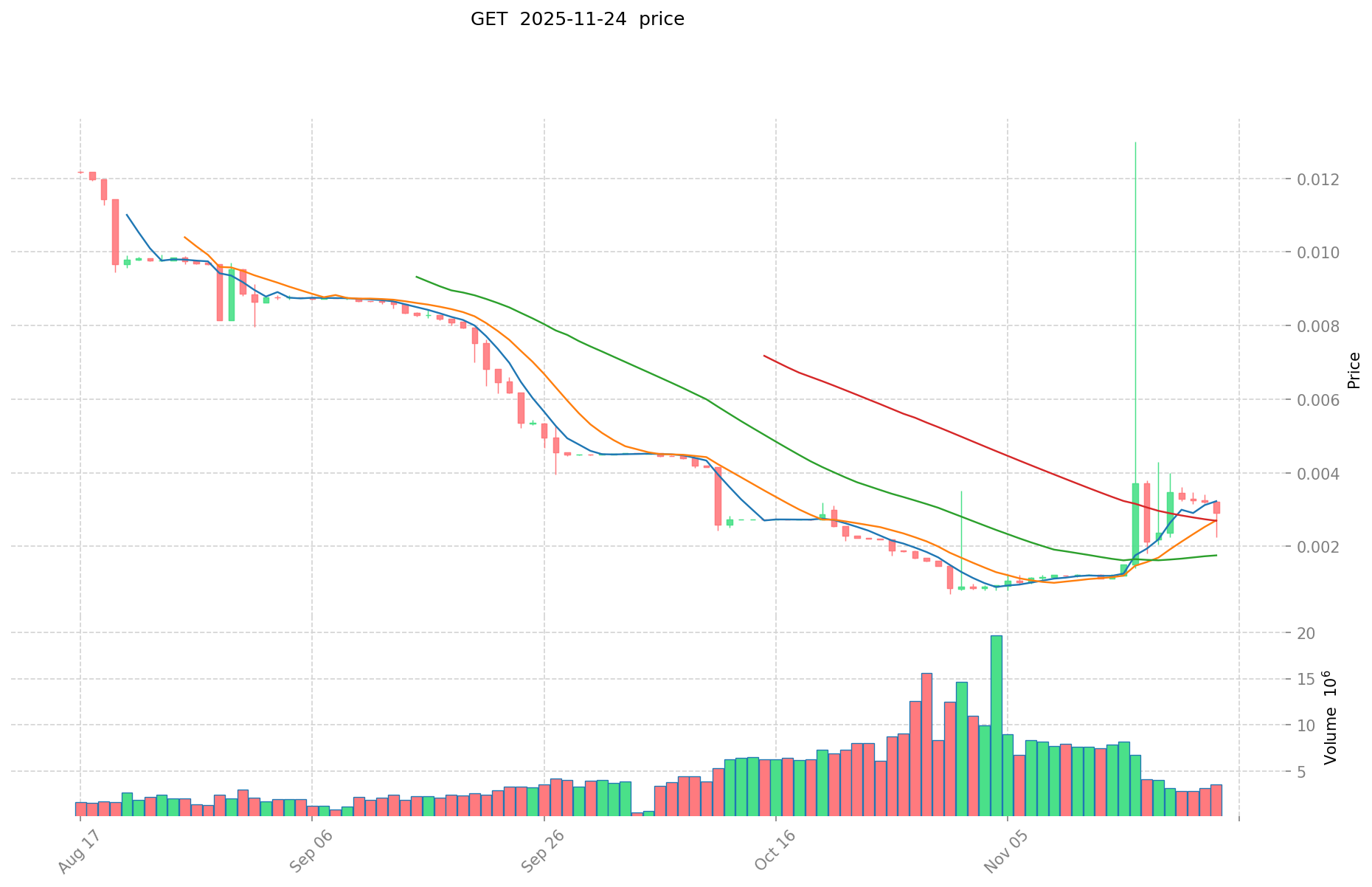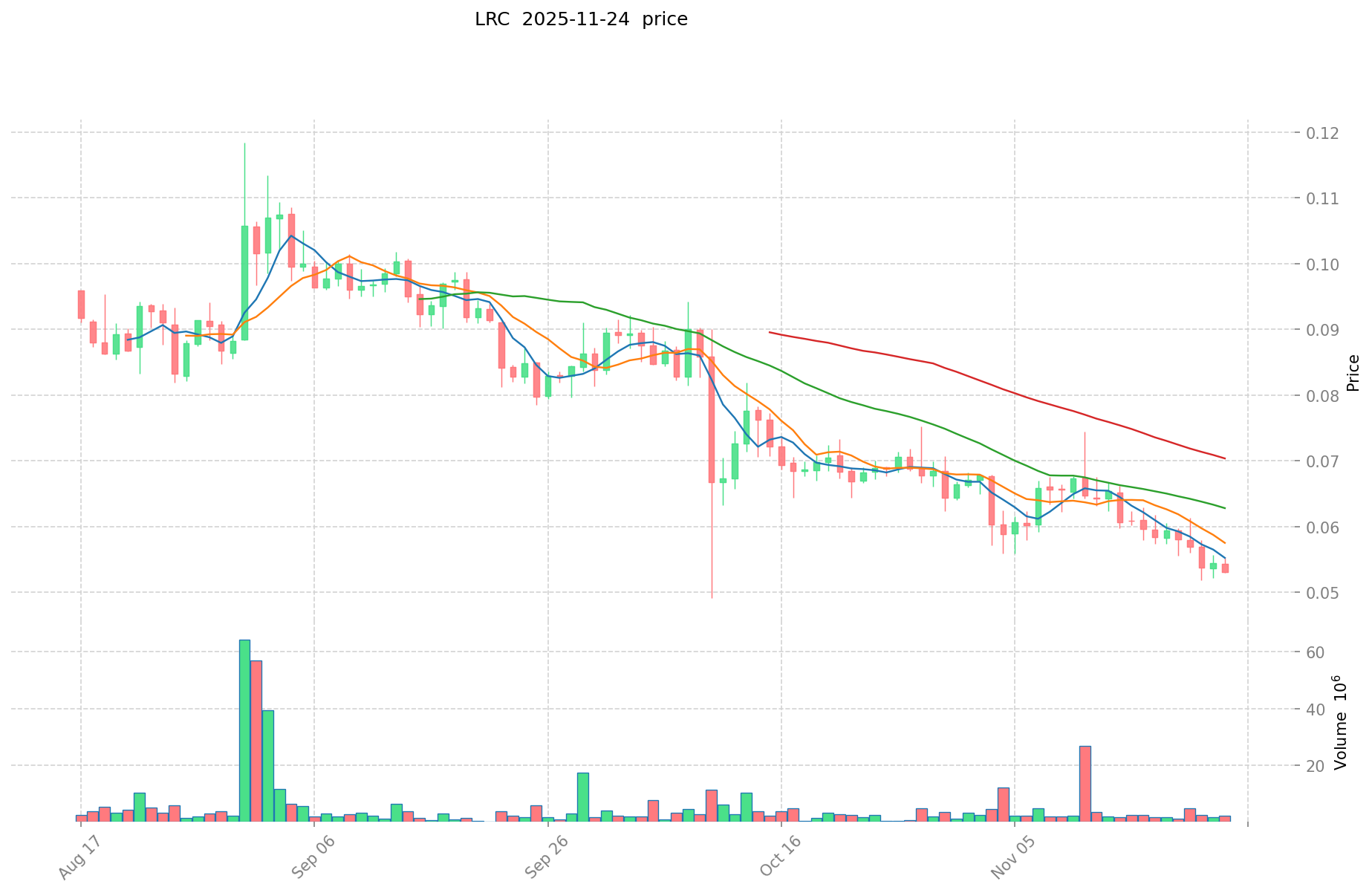GET vs LRC: Comparing Two Popular Approaches to Lyric Synchronization in Music
Introduction: GET vs LRC Investment Comparison
In the cryptocurrency market, the comparison between GET vs LRC has always been a topic that investors can't avoid. The two not only have significant differences in market cap ranking, application scenarios, and price performance, but also represent different crypto asset positioning.
Global Entertainment Token (GET): Launched on the Cardano chain, it aims to become a common currency for the global entertainment industry.
Loopring (LRC): Since its launch in 2017, it has been recognized as an open multi-token transaction protocol based on ERC20 and smart contracts.
This article will comprehensively analyze the investment value comparison between GET vs LRC in terms of historical price trends, supply mechanisms, institutional adoption, technical ecosystems, and future predictions, and attempt to answer the question that investors are most concerned about:
"Which is the better buy right now?"
I. Price History Comparison and Current Market Status
Global Entertainment Token (GET) and Loopring (LRC) Historical Price Trends
- 2021: LRC reached an all-time high of $3.75 on November 10, 2021.
- 2025: GET hit its all-time low of $0.000695 on October 31, 2025.
- Comparative analysis: In the recent market cycle, GET dropped from its all-time high of $0.0336 to $0.0032604, while LRC declined from $3.75 to $0.0561.
Current Market Situation (2025-11-25)
- GET current price: $0.0032604
- LRC current price: $0.0561
- 24-hour trading volume: GET $9,808.95 vs LRC $87,766.82
- Market Sentiment Index (Fear & Greed Index): 19 (Extreme Fear)
Click to view real-time prices:
- View GET current price Market Price
- View LRC current price Market Price
II. Project Overview and Technological Comparison
Global Entertainment Token (GET)
GET is a native token issued on the Cardano chain, aiming to become a common currency for the global entertainment industry. It allows collaboration within the ecosystem and enables users to access content, support projects, and participate in decision-making.
Loopring (LRC)
Loopring is an open, multi-token transaction protocol based on ERC20 and smart contracts. It provides a decentralized exchange model with zero risk and allows multiple exchanges to compete for off-chain matching and on-chain settlement of orders.
Technical Comparison
- Blockchain: GET is based on Cardano, while LRC operates on Ethereum.
- Use Case: GET focuses on the entertainment industry, whereas LRC targets decentralized exchanges and trading.
- Technology: GET leverages Cardano's capabilities, while LRC utilizes zero-knowledge proofs for scalability and security.
III. Market Performance Analysis
Global Entertainment Token (GET)
- Market Cap: $1,630,200
- Circulating Supply: 500,000,000 GET
- 24h Trading Volume: $9,808.95
- 24h Price Change: +9.28%
Loopring (LRC)
- Market Cap: $69,900,121
- Circulating Supply: 1,245,991,468 LRC
- 24h Trading Volume: $87,766.82
- 24h Price Change: +4.87%
Comparative Analysis
- Market Cap: LRC's market cap is significantly larger than GET's.
- Trading Volume: LRC shows higher liquidity with a much larger 24h trading volume.
- Price Movement: Both tokens show positive 24h price changes, with GET slightly outperforming LRC.
IV. Investment Considerations
Potential Opportunities
- GET: Potential growth in the entertainment industry adoption.
- LRC: Established presence in the DeFi and DEX sectors.
Potential Risks
- GET: Relatively new project with lower market cap and liquidity.
- LRC: Highly competitive DEX market and potential regulatory challenges.
Long-term Outlook
- GET: Success depends on adoption in the entertainment industry and Cardano ecosystem growth.
- LRC: Future tied to the development of layer 2 solutions and DEX popularity.


II. Core Factors Affecting the Investment Value of GET vs LRC
Supply Mechanism Comparison (Tokenomics)
- LRC: Functions as a utility token within the Ethereum Layer 2 scaling solution ecosystem
- GET: Not mentioned in the provided information
- 📌 Historical Pattern: The sustainability of ecosystem development directly impacts token value, with price volatility being a significant characteristic in short-term trading.
Institutional Adoption and Market Applications
- Institutional Holdings: Information not available in the provided context
- Enterprise Adoption: LRC serves as an Ethereum Layer 2 extension solution to address scalability issues
- Regulatory Attitudes: Information not available in the provided context
Technical Development and Ecosystem Building
- LRC Technical Development: Functions as an Ethereum Layer 2 solution designed to enhance scalability
- GET Technical Development: Information not available in the provided context
- Ecosystem Comparison: LRC's value fundamentally depends on its ecosystem development and continuous value creation; the sustainability of Loopring's ecosystem and community support are key factors
Macroeconomic Factors and Market Cycles
- Performance in Inflationary Environments: Information not available in the provided context
- Monetary Policy Effects: Short-term price volatility is significant for LRC, with reports of dramatic price fluctuations (up to 109.29% within 24 hours according to Bitget)
- Geopolitical Factors: Information not available in the provided context
III. 2025-2030 Price Predictions: GET vs LRC
Short-term Forecast (2025)
- GET: Conservative $0.002575716 - $0.0032604 | Optimistic $0.0032604 - $0.003358212
- LRC: Conservative $0.0497154 - $0.05586 | Optimistic $0.05586 - $0.0636804
Mid-term Forecast (2027)
- GET may enter a growth phase, with estimated price range $0.0019205557371 - $0.0038411114742
- LRC may enter a bullish market, with estimated price range $0.03838442244 - $0.09669921807
- Key drivers: Institutional capital inflow, ETF, ecosystem development
Long-term Forecast (2030)
- GET: Base scenario $0.00411487854122 - $0.004690961536991 | Optimistic scenario $0.004690961536991+
- LRC: Base scenario $0.053315651633889 - $0.100595569120546 | Optimistic scenario $0.100595569120546 - $0.110655126032601
Disclaimer: This forecast is for informational purposes only and should not be considered as financial advice. Cryptocurrency markets are highly volatile and unpredictable. Always conduct your own research before making any investment decisions.
GET:
| 年份 | 预测最高价 | 预测平均价格 | 预测最低价 | 涨跌幅 |
|---|---|---|---|---|
| 2025 | 0.003358212 | 0.0032604 | 0.002575716 | 0 |
| 2026 | 0.00393807414 | 0.003309306 | 0.00274672398 | 1 |
| 2027 | 0.0038411114742 | 0.00362369007 | 0.0019205557371 | 11 |
| 2028 | 0.004068316841589 | 0.0037324007721 | 0.002351412486423 | 14 |
| 2029 | 0.004329398275597 | 0.003900358806844 | 0.002106193755696 | 19 |
| 2030 | 0.004690961536991 | 0.00411487854122 | 0.002304331983083 | 26 |
LRC:
| 年份 | 预测最高价 | 预测平均价格 | 预测最低价 | 涨跌幅 |
|---|---|---|---|---|
| 2025 | 0.0636804 | 0.05586 | 0.0497154 | 0 |
| 2026 | 0.087862194 | 0.0597702 | 0.04781616 | 6 |
| 2027 | 0.09669921807 | 0.073816197 | 0.03838442244 | 32 |
| 2028 | 0.1091298656448 | 0.085257707535 | 0.05712266404845 | 52 |
| 2029 | 0.103997351651193 | 0.0971937865899 | 0.093306035126304 | 73 |
| 2030 | 0.110655126032601 | 0.100595569120546 | 0.053315651633889 | 79 |
IV. Investment Strategy Comparison: GET vs LRC
Long-term vs Short-term Investment Strategies
- GET: Suitable for investors focused on entertainment industry potential and Cardano ecosystem growth
- LRC: Suitable for investors interested in DeFi and DEX sector development
Risk Management and Asset Allocation
- Conservative investors: GET: 20% vs LRC: 80%
- Aggressive investors: GET: 40% vs LRC: 60%
- Hedging tools: Stablecoin allocation, options, cross-currency portfolio
V. Potential Risk Comparison
Market Risks
- GET: Lower liquidity and market cap, potentially higher volatility
- LRC: Competitive DEX market, potential for rapid price fluctuations
Technical Risks
- GET: Scalability, network stability of the Cardano ecosystem
- LRC: Ethereum network congestion, potential Layer 2 scaling issues
Regulatory Risks
- Global regulatory policies may have differing impacts on entertainment tokens and DeFi protocols
VI. Conclusion: Which Is the Better Buy?
📌 Investment Value Summary:
- GET advantages: Potential growth in entertainment industry adoption, Cardano ecosystem exposure
- LRC advantages: Established presence in DeFi, Layer 2 scaling solution for Ethereum
✅ Investment Advice:
- New investors: Consider a small allocation to LRC for exposure to the DeFi sector
- Experienced investors: Balanced portfolio with both GET and LRC, adjusting based on risk tolerance
- Institutional investors: Focus on LRC due to its larger market cap and established ecosystem
⚠️ Risk Warning: The cryptocurrency market is highly volatile. This article does not constitute investment advice. None
VII. FAQ
Q1: What are the main differences between GET and LRC? A: GET is a native token on the Cardano blockchain focused on the entertainment industry, while LRC is an Ethereum-based token designed for decentralized exchanges and Layer 2 scaling solutions.
Q2: Which token has a larger market cap and trading volume? A: LRC has a significantly larger market cap ($69,900,121) and 24-hour trading volume ($87,766.82) compared to GET's market cap of $1,630,200 and 24-hour trading volume of $9,808.95.
Q3: What are the potential opportunities for each token? A: GET offers potential growth in entertainment industry adoption, while LRC has an established presence in the DeFi and DEX sectors.
Q4: What are the main risks associated with investing in GET and LRC? A: GET risks include being a relatively new project with lower market cap and liquidity. LRC faces risks from a highly competitive DEX market and potential regulatory challenges.
Q5: How do the price predictions for GET and LRC compare for 2030? A: By 2030, GET's base scenario price range is predicted to be $0.00411487854122 - $0.004690961536991, while LRC's base scenario range is $0.053315651633889 - $0.100595569120546.
Q6: What investment strategies are recommended for GET and LRC? A: For conservative investors, a 20% GET to 80% LRC allocation is suggested. For aggressive investors, a 40% GET to 60% LRC split is recommended.
Q7: Which token might be more suitable for different types of investors? A: New investors might consider a small allocation to LRC for DeFi exposure. Experienced investors could balance both GET and LRC. Institutional investors may focus more on LRC due to its larger market cap and established ecosystem.
Share
Content